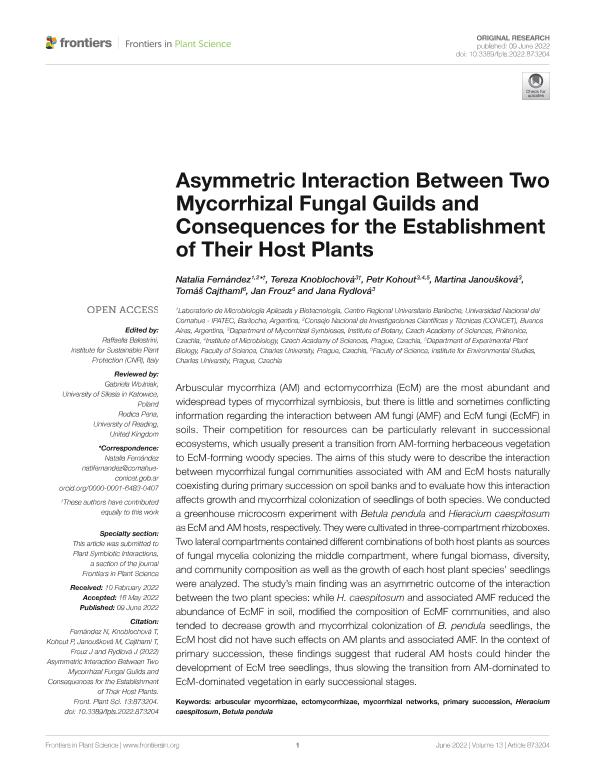Artículo
Asymmetric Interaction Between Two Mycorrhizal Fungal Guilds and Consequences for the Establishment of Their Host Plants
Fernández, Natalia Verónica ; Knoblochová, Tereza; Kohout, Petr; Janoušková, Martina; Cajthaml, Tomáš; Frouz, Jan; Rydlová, Jana
; Knoblochová, Tereza; Kohout, Petr; Janoušková, Martina; Cajthaml, Tomáš; Frouz, Jan; Rydlová, Jana
 ; Knoblochová, Tereza; Kohout, Petr; Janoušková, Martina; Cajthaml, Tomáš; Frouz, Jan; Rydlová, Jana
; Knoblochová, Tereza; Kohout, Petr; Janoušková, Martina; Cajthaml, Tomáš; Frouz, Jan; Rydlová, Jana
Fecha de publicación:
06/2022
Editorial:
Frontiers Media
Revista:
Frontiers in Plant Science
ISSN:
1664-462X
Idioma:
Inglés
Tipo de recurso:
Artículo publicado
Clasificación temática:
Resumen
Arbuscular mycorrhiza (AM) and ectomycorrhiza (EcM) are the most abundant and widespread types of mycorrhizal symbiosis, but there is little and sometimes conflicting information regarding the interaction between AM fungi (AMF) and EcM fungi (EcMF) in soils. Their competition for resources can be particularly relevant in successional ecosystems, which usually present a transition from AM-forming herbaceous vegetation to EcM-forming woody species. The aims of this study were to describe the interaction between mycorrhizal fungal communities associated with AM and EcM hosts naturally coexisting during primary succession on spoil banks and to evaluate how this interaction affects growth and mycorrhizal colonization of seedlings of both species. We conducted a greenhouse microcosm experiment with Betula pendula and Hieracium caespitosum as EcM and AM hosts, respectively. They were cultivated in three-compartment rhizoboxes. Two lateral compartments contained different combinations of both host plants as sources of fungal mycelia colonizing the middle compartment, where fungal biomass, diversity, and community composition as well as the growth of each host plant species’ seedlings were analyzed. The study’s main finding was an asymmetric outcome of the interaction between the two plant species: while H. caespitosum and associated AMF reduced the abundance of EcMF in soil, modified the composition of EcMF communities, and also tended to decrease growth and mycorrhizal colonization of B. pendula seedlings, the EcM host did not have such effects on AM plants and associated AMF. In the context of primary succession, these findings suggest that ruderal AM hosts could hinder the development of EcM tree seedlings, thus slowing the transition from AM-dominated to EcM-dominated vegetation in early successional stages.
Archivos asociados
Licencia
Identificadores
Colecciones
Articulos(IPATEC)
Articulos de INSTITUTO ANDINO PATAGONICO DE TECNOLOGIAS BIOLOGICAS Y GEOAMBIENTALES
Articulos de INSTITUTO ANDINO PATAGONICO DE TECNOLOGIAS BIOLOGICAS Y GEOAMBIENTALES
Citación
Fernández, Natalia Verónica; Knoblochová, Tereza; Kohout, Petr; Janoušková, Martina; Cajthaml, Tomáš; et al.; Asymmetric Interaction Between Two Mycorrhizal Fungal Guilds and Consequences for the Establishment of Their Host Plants; Frontiers Media; Frontiers in Plant Science; 13; 6-2022; 1-13
Compartir
Altmétricas



